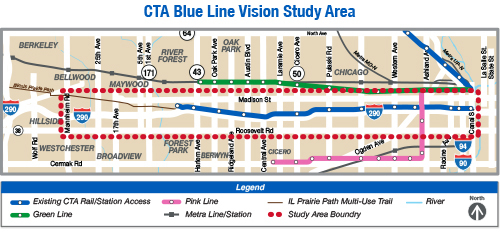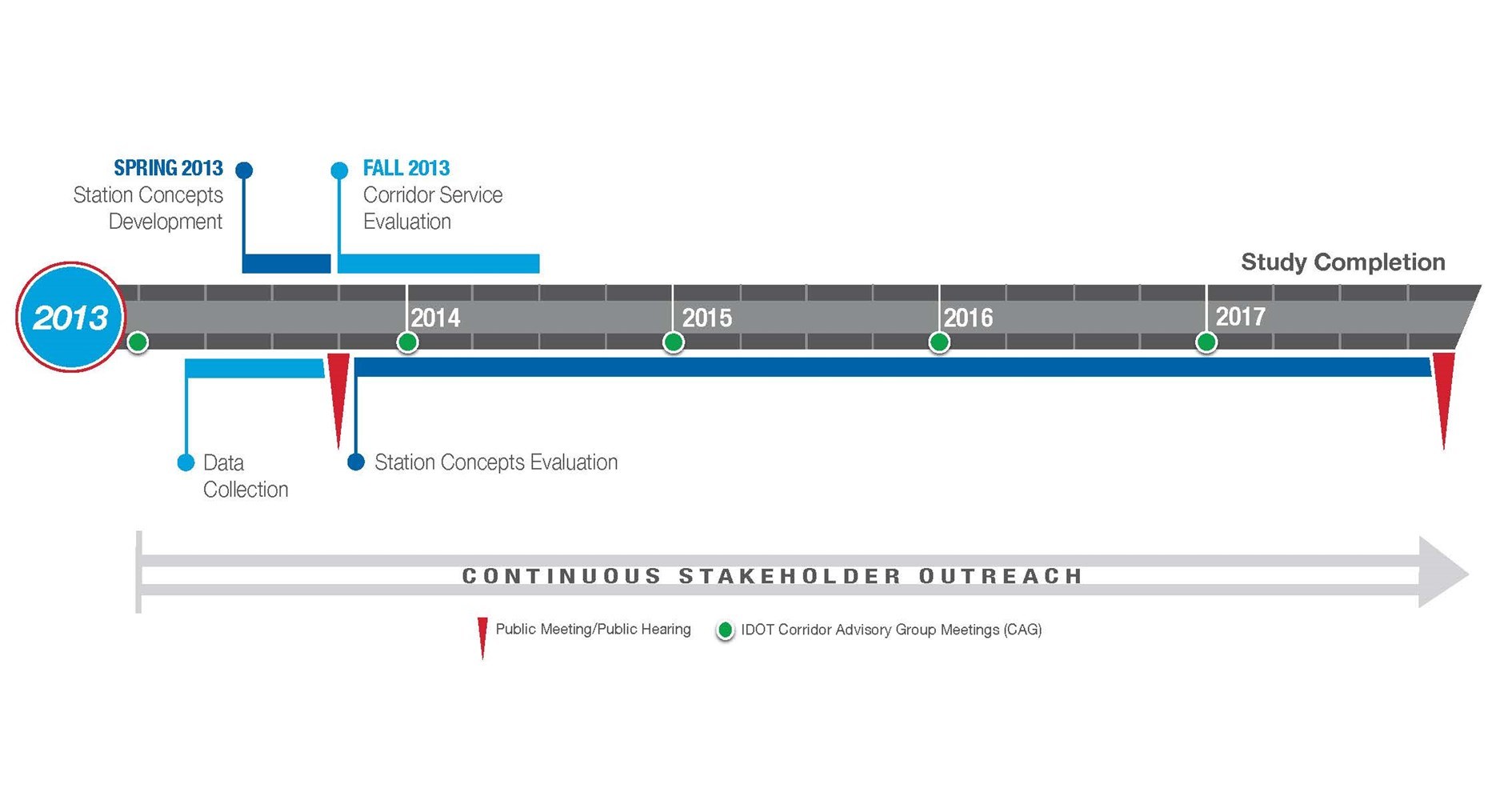This page provides information regarding the CTA’s Blue Line Forest Park Branch Feasibility/Vision Study, process, and schedule.
On this page
Project overview
Project background
The Chicago Transit Authority (CTA) initiated the Blue Line Forest Park Branch Feasibility/Vision Study in 2013 to determine a long-term planning strategy for the Blue Line Forest Park Branch, with study limits including the entire Blue Line Forest Park Branch from Clinton station to Forest Park station, including the evaluation of potential expansion alternatives proposed by the Illinois Department of Transportation (IDOT) through their adjacent I-290 Environmental Impact Statement (EIS) Study that continues to Mannheim Road. CTA’s Blue Line Forest Park Branch Feasibility/Vision Study concluded in 2017.
The Blue Line Forest Park Branch Feasibility/Vision Study includes an assessment of transit and highway integrated enhancements, regional mobility issues, and identification of funding sources and future collaboration opportunities. Concepts for all stations in the study area include, but are not limited to, station access, redesign opportunities, and right-of-way (ROW) needs at specific stations along the corridor. The study includes innovative solutions that preserve transit, but also integrate highway and transit operations to maximize mobility in this important regional corridor.
 The Blue Line Forest Park Branch Feasibility/Vision Study area includes the CTA Blue Line Forest Park branch and an expanded area to the west to evaluate proposed IDOT high-capacity transit expansion alternatives. Specifically, from east to west, the study area is from Canal Street (one block east of Clinton Station) to Mannheim Road. From north to south, the study area is from Roosevelt Road to Madison Street.
The Blue Line Forest Park Branch Feasibility/Vision Study area includes the CTA Blue Line Forest Park branch and an expanded area to the west to evaluate proposed IDOT high-capacity transit expansion alternatives. Specifically, from east to west, the study area is from Canal Street (one block east of Clinton Station) to Mannheim Road. From north to south, the study area is from Roosevelt Road to Madison Street.
Study process
1: Data Collection and Existing Conditions Assessment
This stage of the project development process included: assessing existing conditions and deficiencies within the study area corridor; reaching out to local stakeholders and other interested parties about the project; and hosting a public open house to identify study area issues/concerns.
2: Develop Conceptual Alternatives
This stage of the project consisted of the development and analysis of project alternatives. The goal of this step was to identify a series of alternatives and potential solutions that are suitable to meet the project and stakeholder goals that were identified in Step One.
3: Evaluate and Refine Alternatives
The process concluded with the evaluation and refinement of the corridor service alternatives and recommendations.
Project schedule

Public Involvement
Introduction
Stakeholder involvement was a key component of the Forest Park Branch Feasibility/Vision Study. A stakeholder is defined as anyone who could be affected by the project and has a stake in its outcome. CTA gathered focused and direct input from all interested stakeholders throughout the study process.
CTA’s public involvement process provided information, including project status updates, and several opportunities for feedback regarding upcoming public meeting events and project schedule.
Outreach meetings
The Blue Line Forest Park Branch Feasibility/Vision Study included stakeholder outreach to solicit input on and achieve a general understanding of the issues, and to identify potential solutions for the project. Stakeholder outreach was coordinated with the I-290 EIS, and Blue Line Feasibility/Vision Study findings and input opportunities were added to IDOT’s stakeholder outreach program. CTA provided project updates at Public Meetings held in 2013, and participated in IDOT’s I-290 EIS Corridor Advisory Group meetings held throughout 2013, 2014, 2015 and 2016. The outreach process concluded with a joint CTA/IDOT Open House on June 29, 2016 and a Public Hearing in January 2017, in coordination with IDOT’s I-290 EIS Study, where CTA and IDOT jointly presented final study recommendations from the two projects in the multimodal corridor.
Community members and other project stakeholders were able to share their thoughts and concerns at the outreach meetings. Questions raised by meeting participants were either answered immediately or addressed in subsequent meetings, letters or other communication mechanisms. All comments received at the public meetings were documented, and that information informed the analysis and evaluation of the proposed alternatives. Individuals on the mailing list were notified of meeting dates and times throughout the study.
Outreach materials from past meetings
- CTA Public Comment Form from joint CTA / IDOT Public Hearings on January 25 and 26, 2017 (.pdf)
- CTA Fact Sheet from joint CTA / IDOT Public Hearings on January 25 and 26, 2017 (.pdf )
Text version of Fact Sheet (.pdf)
- CTA Boards from joint CTA / IDOT Public Hearings on January 25 and 26, 2017 (.pdf)
Text version of CTA boards (.pdf)
- Link to IDOT Presentation from joint CTA / IDOT Public Hearings on January 25 and 26, 2017
- CTA Presentation from IDOT I-290 EIS Corridor Advisory Group Meeting #22 on December 14, 2016 (.pdf)
Text version of CTA presentation (.pdf)
- CTA Presentation from City of Chicago Open House on June 29, 2016 (.pdf)
Text version of CTA presentation (.pdf)
Text version of CTA presentation script (.pdf)
- CTA Boards from City of Chicago Open House on June 29, 2016 (.pdf)
Text version of CTA boards (.pdf)
- CTA Fact Sheet from City of Chicago Open House on June 29, 2016 (.pdf)
Text version of Fact Sheet (.pdf)
- CTA Presentation from Village of Oak Park Board Meeting on October 26, 2015 (.pdf)
(.pdf)
- CTA Presentation from Village of Forest Park Council Meeting on October 13, 2015 (.pdf)
Text version of CTA presentation (.pdf)
- CTA Boards from Village of Forest Park Council Meeting on October 13, 2015 (.pdf)
Text version of CTA boards (.pdf)
- CTA Presentation from IDOT I-290 EIS Corridor Advisory Group Meeting #20 on August 27, 2015 (.pdf)
Text version of CTA presentation (.pdf)
- CTA Presentation from IDOT I-290 EIS Corridor Advisory Group Meeting #18 on July 30, 2014 (.pdf)
Text version of CTA presentation (.pdf)
- CTA Presentation from joint IDOT / CTA Public Meetings on October 7 and 8, 2013 (.pdf)
Text version of CTA presentation (.pdf)
CTA Boards from joint IDOT / CTA Public Meetings on October 7 and 8, 2013 (.pdf)
Text version of CTA boards (.pdf)
- CTA Presentation from IDOT I-290 EIS Corridor Advisory Group Meeting #16 on July 17, 2013 (.pdf)
Text version of CTA presentation (.pdf)
- CTA Presentation from IDOT I-290 EIS Corridor Advisory Group Meeting #15 on February 21, 2013 (.pdf)
Text version of CTA presentation (.pdf)
Study Documents
Blue Line Forest Park Branch Feasibility/Vision Study project documents are available below. These documents include draft and final reports; study area maps; presentations; and FAQs, glossary of terms, project photos, graphics, and other communication materials.
- Station and Station Access Alternatives – Final Report Part 1 of 3, April 2017
- Station and Station Access Alternatives – Final Report Part 2 of 3, April 2017
- Station and Station Access Alternatives – Final Report Part 3 of 3, April 2017
- Summary Public Comments and Responses from 1/25 and 1/26/2017 Public Hearings and Open Comment Period, April 2017
- Transit Ridership Forecasting Analysis – Final Report, December 2016
- Conceptual Service Patterns – Final Report, March 2015
- Evaluation of Transit Markets – Final Report, January 2014
- Responses to Public Comments from 10/7 and 10/8/2013 Public Meetings and Open Comment Period, February 2014
- Summary of Public Comments from 10/7 and 10/8/2013 Public Meetings and Open Comment Period, February 2014
- Appendix to Public Comments from 10/7 and 10/8/2013 Public Meetings and Open Comment Period, February 2014
- Existing Conditions Assessment Executive Summary, September 2013
- CTA Announces study to modernize West Side branch of Blue Line, June 2013